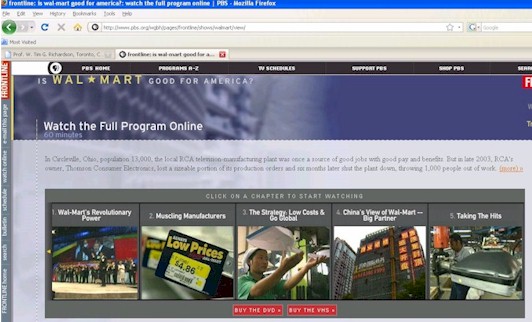globalization and the influences of very large companies

| Wal-Mart
globalization and the influences of very large companies |
 |
updated 2009
Jan 12
 |
this is a screen capture from the section on the PBS site where you can see clips from the Walmart video |
notes from what Prof. Hezai provided C46 students , who viewed this video, in 2008
1 question from this video
will appear on the final
Wal-Mart - biggest retailer
in the U.S. and number one customer in China; annual revenue - 256 billion
US dollars (quarter of Canadian GDP); “team Wal-Mart”
WM utilized rise of information
technology and globalization to their advantage; WM is perhaps the most
powerful retailer in global economy
WM as epitome of one-stop
shopping: wide selection of virtually all possible consumer goods at one
store attracts shoppers
WM extensively uses barcode
info: utilize device that keeps track of qty sold, qty left, hourly/daily/weekly/monthly
trends and projections
World leader in logistics
– some quote WM’s efforts increased overall US efficiency
Pioneered shift from push
production to pull production. Push production: manufacturer decides what
and how to produce, then pushes the product to a retailer. Pull production:
retailer decides what is being sold and sells manufacturer what and how
to produce and at what cost; manufacturer has little control over production
since WM dictates demands.
WM possesses extensive info
on all of its suppliers (their operations, costs, etc.) and establishes
the price at which it will buy goods (“WM way or no way”). Suppliers want
to establish tight relationships with big-box retailers like Wal-Mart which
comes at a price to them. WM pressures its suppliers to keeps costs low;
wouldn’t accept price increase from Rubbermaid whose raw material costs
rose sharply. WM dropped a number of Rubbermaid products driving them out
of business. Rubbermaid sold to Newell and thousands of jobs were cut.
WM business practices: daily
morning “pep rally” meetings.
Emphasis on the opening
price point: each isle has a display of a very low-priced item – serves
as bait to lure customers; items further in the aisle are higher-priced
and aren’t necessarily competitive on the market
Global cost cutting and
efficiency; aggressive growth (WM resisted turning into “rich, fat and
dumb” enterprise)
60-80% margin on Chinese-made
goods compared with 18-22% margin on American-made items
WM has the power to push
its suppliers into low-cost geographical regions
China:
Discussion
WM creates culture of waste,
i.e. everything in abundance, when something breaks down people simply
buy more
WM causes pollution (heavy-traffic
sea transport, shipments from China )
| Others | While Wal-Mart seems to bear the brunt of much media focus on big retailers (just like McDonald's is the focus of fast food companies) there are a number of other significant global retailers that also have business circumstances which have a global effect, just like Wal-Mart |
Australia – Woolworths Ltd.
Convenience/Forecourt Store,
Discount Department Store, Electronics Specialty, Other Specialty, Supermarket
Brazil – Comanhia Brasileira
de Distribuicao SA Grupo Pao De Acucar
Convenience/Forecourt Store,
Electronics Specialty, Hypermarket/Supercenter/Superstore, Supermarket
Canada – Loblaw Companies, Ltd.
China – Bailian Group
France - Carrefour
Germany - Metro AG
Hong Kong – AS Watson & Company Ltd. SAR
Mexico – Organizacion Soriana S.A. de C.V.
South Korea -- Lotte Shopping Co., Ltd.
Sweden – The IKEA Group
|
|
CONTACT I MAIN PAGE I NEWS GALLERY I E-BIZ SHORTCUTS I INT'L BIZ SHORTCUTS I MKTG&BUSINESS SHORTCUTS I TEACHING SCHEDULE |
| . | |
|
MISTAKES
I TEXTS
USED I
IMAGES
I RANK
I DISCLAIMER
I STUDENT
CONTRIBUTORS I FORMER
STUDENTS I PUBLICATIONS
I |
|
| . |